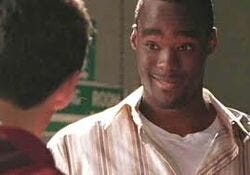Emeka Okafor vs. Dwight Howard: The Rivalry That Never Became
Easy to overlook amid Devin Booker’s struggles, Chris Paul’s unfortunate injury and the Lakers finally playing at full-strength is that the Phoenix Suns best player in their playoff series has been Deandre Ayton.
Ayton has been a consistent double-double player throughout his NBA career, but going No. 1 overall in a draft class that also featured Luka Doncic and Trae Young demanded the center to not just be solid, but a star. He was a good role player for the better part of two-plus years, but not a star.
I trucked up to Las Vegas in 2018 for a story on his potential, and teammates and opponents alike gushed about Ayton’s game. His showing in his first postseason is approaching the standard expected when he came out of college. This could mark the rounding of a corner that a big man forerunner never reached: Emeka Okafor.
Okafor went second in the 2004 NBA draft behind Dwight Howard — which, in its own right, should give you a sense how different that era of basketball was compared to today. Centers going 1 and 2?!
But the two came into the NBA at a time of transition, before the advent of prevalent positionless basketball and coinciding with turnover among the league’s dominant big men.
Hakeem Olajuwon was done by 2004; so was Patrick Ewing. David Robinson retired a year earlier, announcing his exit immediately after winning his second championship alongside Tim Duncan. Duncan had already established himself as the league’s preeminent big man by 2004, and Shaquille O’Neal still had one more near-peak run left in him with an MVP-caliber 2004-05 season.
Otherwise, the mid-2000s came with a power vacuum in the middle that Howard or Okafor, maybe both, would fill. There was a certain poetry to the big-man rivalry of the future coming 10 years after the unofficial Season of the Center, 1994 — a season in which David Robinson dropped 71 points on the final day to secure the scoring title…
…and Hakeem Olajuwon concluded his MVP campaign with an NBA championship, won against Patrick Ewing.
While Olajuwon’s 1993-94 is the stuff of hardwood legend, Ewing played one of the best seasons of his career then, too. Adding to the symmetry of Howard-Okafor going 1-2 in 2004, the ‘94 season came another 10 years after the 1984 Final Four in which Ewing’s Georgetown Hoyas beat Olajuwon’s Houston Cougars for the national championship.
Coinciding with Shaq’s fast-growing rep in Year 2 with Orlando, the NBA of 1994 resembled a kaiju movie: big, bad monsters battling it out for supremacy. Howard-Okafor seemed destined to return us to such a time.
I was, admittedly, Team Okafor all the way. High school-to-pros players were making an indelible mark on the NBA in the first half of the 2000s, but for every KG, Kobe, LeBron or Amare’, there were multiple draftees like Jonathan Bender, Korleone Young or a significant chunk of the 2001 draft class (more on it coming soon) that made little or no impact.
The NBA itself seemingly agreed, barring preps from jumping straight to the pros the next year.
Maybe Dwight Howard would be a star, but virtually all prep prospects save for LeBron were drafted on upside. His selection to Orlando felt like far more of a crapshoot than the new Charlotte Bobcats taking Okafor at No. 2.
After all, Okafor was fresh off a dominant 2003-04 college basketball season in which he won a variety of Player of the Year awards for posting 17.6 points, 11.5 rebounds and 4.1 blocks per game en route to UConn’s second national championship.
The race between Okafor and St. Joseph’s Jameer Nelson — coincidentally, a longtime teammate of Howard’s at Orlando — for Player of the Year still ranks among the most compelling such competitions for college hoops honors. And Okafor emerged on top.
I felt vindicated in my Okafor vs. Howard position after their first season. Okafor averaged 15.1 points and 10.9 rebounds per game in 2004-05 to win Rookie of the Year and seemingly position himself to be the long-term face of the new Charlotte organization.
Another point in Okafor’s favor? He appeared on One Tree Hill as a rookie.
But while 2004-05 marked the first of five consecutive seasons in which Okafor averaged a double-double, he just never ascended to stardom. Howard, meanwhile and for all his faults, grew into the best big man of the late 2000s.
Perhaps the ankle injury that sidelined Okafor for 56 games in his second year stunted his potential — in which case, my ranking of the most impactful injuries in NBA history deserves a revisit.
If nothing else, it denied Okafor an opportunity for a transformative moment akin to Ayton’s in the Playoffs. In retrospect, it was also the last gasp of the era of a center-dominated league.
Certainly, there was never another draft with the same potential to develop a big-man rivalry. Kevin Durant played power forward at Texas, but was never going to be the pro post player that some, like myself, expected Greg Oden to become.
The game’s shift to a far more perimeter-oriented style also complicates the prospects of a marquee rivalry between centers. Perhaps a shift is underway with a center, Nikola Jokic, primed to win MVP; another in Joel Embiid in contention for the award; and Ayton moving toward meeting his potential.
For now, though, Okafor-Howard closed a long chapter on basketball history.




